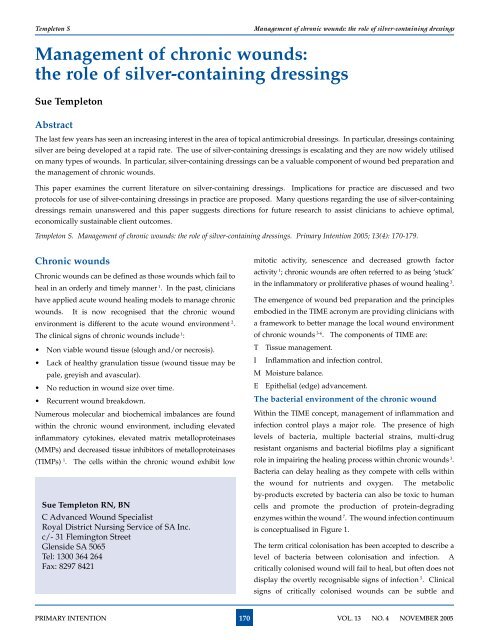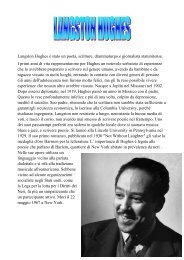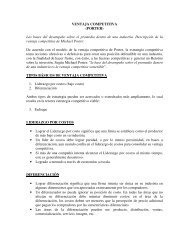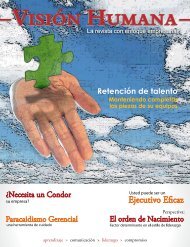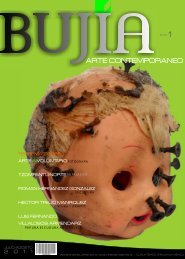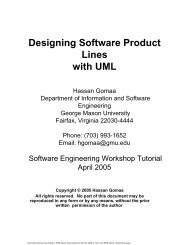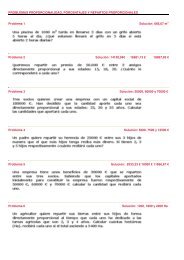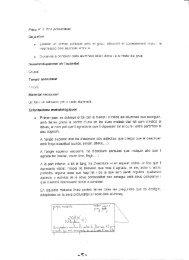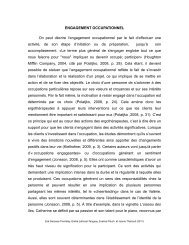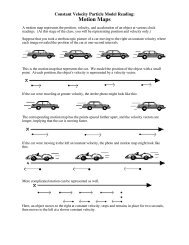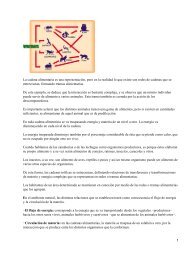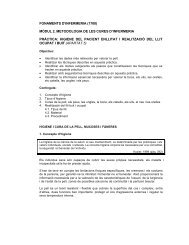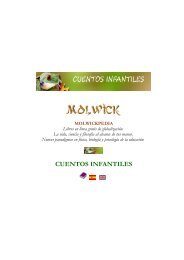Management of chronic wounds: the role of silver-containing dressings
Management of chronic wounds: the role of silver-containing dressings
Management of chronic wounds: the role of silver-containing dressings
Create successful ePaper yourself
Turn your PDF publications into a flip-book with our unique Google optimized e-Paper software.
Templeton S<br />
<strong>Management</strong> <strong>of</strong> <strong>chronic</strong> <strong>wounds</strong>: <strong>the</strong> <strong>role</strong> <strong>of</strong> <strong>silver</strong>-<strong>containing</strong> <strong>dressings</strong><br />
<strong>Management</strong> <strong>of</strong> <strong>chronic</strong> <strong>wounds</strong>:<br />
<strong>the</strong> <strong>role</strong> <strong>of</strong> <strong>silver</strong>-<strong>containing</strong> <strong>dressings</strong><br />
Sue Templeton<br />
Abstract<br />
The last few years has seen an increasing interest in <strong>the</strong> area <strong>of</strong> topical antimicrobial <strong>dressings</strong>. In particular, <strong>dressings</strong> <strong>containing</strong><br />
<strong>silver</strong> are being developed at a rapid rate. The use <strong>of</strong> <strong>silver</strong>-<strong>containing</strong> <strong>dressings</strong> is escalating and <strong>the</strong>y are now widely utilised<br />
on many types <strong>of</strong> <strong>wounds</strong>. In particular, <strong>silver</strong>-<strong>containing</strong> <strong>dressings</strong> can be a valuable component <strong>of</strong> wound bed preparation and<br />
<strong>the</strong> management <strong>of</strong> <strong>chronic</strong> <strong>wounds</strong>.<br />
This paper examines <strong>the</strong> current literature on <strong>silver</strong>-<strong>containing</strong> <strong>dressings</strong>. Implications for practice are discussed and two<br />
protocols for use <strong>of</strong> <strong>silver</strong>-<strong>containing</strong> <strong>dressings</strong> in practice are proposed. Many questions regarding <strong>the</strong> use <strong>of</strong> <strong>silver</strong>-<strong>containing</strong><br />
<strong>dressings</strong> remain unanswered and this paper suggests directions for future research to assist clinicians to achieve optimal,<br />
economically sustainable client outcomes.<br />
Templeton S. <strong>Management</strong> <strong>of</strong> <strong>chronic</strong> <strong>wounds</strong>: <strong>the</strong> <strong>role</strong> <strong>of</strong> <strong>silver</strong>-<strong>containing</strong> <strong>dressings</strong>. Primary Intention 2005; 13(4): 170-179.<br />
Chronic <strong>wounds</strong><br />
Chronic <strong>wounds</strong> can be defined as those <strong>wounds</strong> which fail to<br />
heal in an orderly and timely manner 1 . In <strong>the</strong> past, clinicians<br />
have applied acute wound healing models to manage <strong>chronic</strong><br />
<strong>wounds</strong>. It is now recognised that <strong>the</strong> <strong>chronic</strong> wound<br />
environment is different to <strong>the</strong> acute wound environment 2 .<br />
The clinical signs <strong>of</strong> <strong>chronic</strong> <strong>wounds</strong> include 1 :<br />
• Non viable wound tissue (slough and/or necrosis).<br />
• Lack <strong>of</strong> healthy granulation tissue (wound tissue may be<br />
pale, greyish and avascular).<br />
• No reduction in wound size over time.<br />
• Recurrent wound breakdown.<br />
Numerous molecular and biochemical imbalances are found<br />
within <strong>the</strong> <strong>chronic</strong> wound environment, including elevated<br />
inflammatory cytokines, elevated matrix metalloproteinases<br />
(MMPs) and decreased tissue inhibitors <strong>of</strong> metalloproteinases<br />
(TIMPs) 1 . The cells within <strong>the</strong> <strong>chronic</strong> wound exhibit low<br />
Sue Templeton RN, BN<br />
C Advanced Wound Specialist<br />
Royal District Nursing Service <strong>of</strong> SA Inc.<br />
c/- 31 Flemington Street<br />
Glenside SA 5065<br />
Tel: 1300 364 264<br />
Fax: 8297 8421<br />
mitotic activity, senescence and decreased growth factor<br />
activity 1 ; <strong>chronic</strong> <strong>wounds</strong> are <strong>of</strong>ten referred to as being ‘stuck’<br />
in <strong>the</strong> inflammatory or proliferative phases <strong>of</strong> wound healing 3 .<br />
The emergence <strong>of</strong> wound bed preparation and <strong>the</strong> principles<br />
embodied in <strong>the</strong> TIME acronym are providing clinicians with<br />
a framework to better manage <strong>the</strong> local wound environment<br />
<strong>of</strong> <strong>chronic</strong> <strong>wounds</strong> 3-6 . The components <strong>of</strong> TIME are:<br />
T Tissue management.<br />
I Inflammation and infection control.<br />
M Moisture balance.<br />
E Epi<strong>the</strong>lial (edge) advancement.<br />
The bacterial environment <strong>of</strong> <strong>the</strong> <strong>chronic</strong> wound<br />
Within <strong>the</strong> TIME concept, management <strong>of</strong> inflammation and<br />
infection control plays a major <strong>role</strong>. The presence <strong>of</strong> high<br />
levels <strong>of</strong> bacteria, multiple bacterial strains, multi-drug<br />
resistant organisms and bacterial bi<strong>of</strong>ilms play a significant<br />
<strong>role</strong> in impairing <strong>the</strong> healing process within <strong>chronic</strong> <strong>wounds</strong> 3 .<br />
Bacteria can delay healing as <strong>the</strong>y compete with cells within<br />
<strong>the</strong> wound for nutrients and oxygen. The metabolic<br />
by-products excreted by bacteria can also be toxic to human<br />
cells and promote <strong>the</strong> production <strong>of</strong> protein-degrading<br />
enzymes within <strong>the</strong> wound 7 . The wound infection continuum<br />
is conceptualised in Figure 1.<br />
The term critical colonisation has been accepted to describe a<br />
level <strong>of</strong> bacteria between colonisation and infection. A<br />
critically colonised wound will fail to heal, but <strong>of</strong>ten does not<br />
display <strong>the</strong> overtly recognisable signs <strong>of</strong> infection 5 . Clinical<br />
signs <strong>of</strong> critically colonised <strong>wounds</strong> can be subtle and<br />
Primary Intention 170<br />
Vol. 13 No. 4 november 2005
Templeton S<br />
<strong>Management</strong> <strong>of</strong> <strong>chronic</strong> <strong>wounds</strong>: <strong>the</strong> <strong>role</strong> <strong>of</strong> <strong>silver</strong>-<strong>containing</strong> <strong>dressings</strong><br />
Figure 1. The wound infection continuum 8 .<br />
Increasing level <strong>of</strong> bacterial load (bioburden)<br />
Contamination Colonisation Critical colonisation Local infection Spreading infection<br />
Evidence <strong>of</strong> delayed healing<br />
covert signs overt signs systemic signs<br />
<strong>the</strong>refore might go unrecognised by clinicians. The signs can<br />
include: failure <strong>of</strong> <strong>the</strong> wound to progress; increased wound<br />
pain or tenderness; increase in serous exudate; absent<br />
granulation tissue or increase in non-viable tissue; friable<br />
granulation tissue and an <strong>of</strong>fensive odour 9 .<br />
There are a number <strong>of</strong> methods to reduce bacterial load<br />
within a wound. Removal <strong>of</strong> non-viable tissue through<br />
debridement will reduce <strong>the</strong> number <strong>of</strong> micro-organisms,<br />
toxins and o<strong>the</strong>r substances within <strong>the</strong> wound bed which<br />
contribute to impaired healing 4 . However, a thorough<br />
assessment <strong>of</strong> <strong>the</strong> patient to determine <strong>the</strong>ir healing capacity<br />
must be undertaken prior to <strong>the</strong> removal <strong>of</strong> hard, dry eschar.<br />
The maintenance <strong>of</strong> eschar is clinically acceptable where <strong>the</strong><br />
patient has inadequate blood supply to <strong>the</strong> wound to allow<br />
healing and support infection control 10 .<br />
Managing inflammation and infection control<br />
Wound bed preparation and <strong>the</strong> TIME concept is primarily<br />
concerned with managing <strong>the</strong> local wound environment to<br />
optimise healing 5, 6 . However, a comprehensive assessment<br />
<strong>of</strong> <strong>the</strong> patient is a pre-requisite prior to applying wound bed<br />
preparation. As Sibbald et al. 3 states, “local wound<br />
management measures are unlikely to succeed if <strong>the</strong> patient<br />
is not receiving adequate treatment for conditions that are<br />
known to impair healing”. Factors such as poorly controlled<br />
diabetes, heart failure, poor vascularity, poor nutrition or<br />
continuing pressure will continue to impair healing and can<br />
thwart <strong>the</strong> best attempts to manage <strong>the</strong> local wound<br />
environment 3 . O<strong>the</strong>r systemic conditions (e.g. rheumatoid<br />
arthritis), certain medications (e.g. corticosteroids) and some<br />
lifestyle choices (e.g. smoking) can also contribute to impaired<br />
wound healing.<br />
Information gained from assessment is used to determine<br />
realistic long-term goals <strong>of</strong> wound management in conjunction<br />
with <strong>the</strong> patient. If factors impairing healing are severe and<br />
cannot be overcome, <strong>the</strong> wound may be unlikely to heal. In<br />
this situation, <strong>the</strong> management plan may be different to that<br />
for a patient with healing capacity.<br />
Implications for practice<br />
Topical antimicrobials<br />
Table 1 outlines an overview <strong>of</strong> <strong>the</strong> antimicrobials that might<br />
be beneficial in managing various levels <strong>of</strong> wound bioburden.<br />
A number <strong>of</strong> terms are used to describe <strong>the</strong> reduction <strong>of</strong><br />
bioburden. These include 11 :<br />
• Antibacterial: a substance which is bactericidal (i.e. kills) or<br />
bacteriostatic (i.e. inhibits) bacteria.<br />
• Antimicrobial: a substance that has cidal or static properties<br />
against microbes. This term is <strong>of</strong>ten used to include<br />
organisms o<strong>the</strong>r than bacteria such as fungi.<br />
There has been renewed interest in topical preparations to assist<br />
in controlling wound bioburden. This brief review considers<br />
some <strong>of</strong> <strong>the</strong> topical antimicrobials utilised in wound management<br />
– povidone iodine, cadexomer iodine and honey.<br />
Antiseptics have been used by clinicians for many years to<br />
control bacteria. Povidone iodine has been recommended as<br />
appropriate for <strong>the</strong> prevention and treatment <strong>of</strong> infected<br />
<strong>wounds</strong> 12-14 , and for reduction <strong>of</strong> bacterial load in <strong>wounds</strong><br />
unlikely to heal 9 . However, Cooper 15 argues that <strong>the</strong><br />
appropriateness <strong>of</strong> topical antiseptics for wound management<br />
remains controversial. In addition, whilst topical antibiotics<br />
can deliver high concentrations to <strong>the</strong> wound, <strong>the</strong> problems <strong>of</strong><br />
Table 1. A guide to antimicrobial management <strong>of</strong> wound bioburden 3 .<br />
Level <strong>of</strong> bioburden Primary Adjunct<br />
treatment treatment<br />
Non-healable wound<br />
Critical colonisation<br />
Antiseptics<br />
Topical<br />
antimicrobials<br />
Local infection Systemic Topical<br />
antibiotics antimicrobials<br />
Spreading infection Systemic Topical<br />
antibiotics antimicrobials<br />
Primary Intention 171<br />
Vol. 13 No. 4 november 2005
Templeton S<br />
<strong>Management</strong> <strong>of</strong> <strong>chronic</strong> <strong>wounds</strong>: <strong>the</strong> <strong>role</strong> <strong>of</strong> <strong>silver</strong>-<strong>containing</strong> <strong>dressings</strong><br />
cutaneous sensitisation, impairment to healing and development<br />
<strong>of</strong> resistant strains means that topical antibiotics are not<br />
recommended for application to <strong>wounds</strong> 16 , although <strong>the</strong><br />
author is aware that this practice still occurs.<br />
Cadexomer iodine is an effective topical antimicrobial agent<br />
that <strong>of</strong>fers controlled release <strong>of</strong> water-soluble iodine in<br />
response to exudate 17 . Cadexomer iodine can assist with<br />
autolysis <strong>of</strong> slough and management <strong>of</strong> exudate while<br />
maintaining a moist wound environment 18 . Clinical trials<br />
using cadexomer iodine on <strong>chronic</strong> <strong>wounds</strong> have demonstrated<br />
improved clinical outcomes compared to o<strong>the</strong>r treatments 1 .<br />
Anecdotal evidence suggests cadexomer iodine may be<br />
appropriate to use as an alternative to <strong>silver</strong>-<strong>containing</strong><br />
<strong>dressings</strong>. However, as yet, <strong>the</strong>re are no guidelines to assist<br />
clinicians in deciding whe<strong>the</strong>r to use cadexomer iodine or a<br />
<strong>silver</strong>-<strong>containing</strong> dressing.<br />
Some honeys are also recognised for <strong>the</strong>ir antimicrobial<br />
properties 19 . The use <strong>of</strong> honey as a topical antimicrobial has<br />
seen a resurgence in recent years.<br />
Unfortunately <strong>the</strong>re is still a paucity <strong>of</strong> guidelines as to which<br />
topical antimicrobial preparation to choose in clinical practice.<br />
The number <strong>of</strong> topical antimicrobial preparations, conflicting<br />
views in <strong>the</strong> literature as to indications and efficacy 20 , and use<br />
based on tradition ra<strong>the</strong>r than evidence has led to confusion<br />
and variance amongst clinicians. In deciding whe<strong>the</strong>r or not to<br />
use topical antimicrobials for wound management, a risk/<br />
benefit analysis, including knowledge <strong>of</strong> <strong>the</strong> advantages and<br />
disadvantages <strong>of</strong> <strong>the</strong> particular antimicrobial, should be<br />
undertaken for each person and <strong>the</strong>ir wound 20 . These<br />
principles also apply to antimicrobial <strong>dressings</strong> <strong>containing</strong><br />
<strong>silver</strong>, which will now be discussed in detail.<br />
Silver-<strong>containing</strong> <strong>dressings</strong><br />
Much has been written in <strong>the</strong> last few years regarding <strong>the</strong><br />
antimicrobial properties <strong>of</strong> <strong>silver</strong> 15, 21-25 . Preparations including<br />
<strong>silver</strong> sulphadiazine cream and <strong>silver</strong> nitrate have been used for<br />
many years, particularly in burn units and for control <strong>of</strong><br />
Pseudomonas aeruginosa 22 . An increasing number <strong>of</strong> <strong>dressings</strong><br />
are now available which contain <strong>silver</strong>. The carrier mediums<br />
for <strong>the</strong>se <strong>dressings</strong> vary and <strong>the</strong>re are <strong>silver</strong>-<strong>containing</strong> <strong>dressings</strong><br />
suitable for most wound exudate levels (Table 2).<br />
Composition <strong>of</strong> <strong>silver</strong>-<strong>containing</strong> <strong>dressings</strong><br />
There is little doubt that <strong>silver</strong>-<strong>containing</strong> <strong>dressings</strong> <strong>of</strong>fer<br />
valuable <strong>the</strong>rapeutic effect 26-30 . However, it has become<br />
increasingly difficult for clinicians to determine which <strong>of</strong><br />
<strong>the</strong>se products <strong>of</strong>fers <strong>the</strong> best efficacy and value. All <strong>the</strong><br />
products claim to contain or release ionic <strong>silver</strong> (Ag+), which<br />
is <strong>the</strong> form necessary for antimicrobial action 15 . However,<br />
many <strong>of</strong> <strong>the</strong> companies do not specify what type <strong>of</strong> <strong>silver</strong><br />
complex is used in <strong>the</strong>ir dressing 25 . Two <strong>of</strong> <strong>the</strong> products claim<br />
to contain nanocrystalline <strong>silver</strong>. Nanocrystalline <strong>silver</strong> is<br />
produced using nanotechnology to reduce <strong>the</strong> <strong>silver</strong> particles<br />
to an extremely small size. This process greatly increases <strong>the</strong><br />
surface area <strong>of</strong> <strong>the</strong> <strong>silver</strong> particles and nanocrystalline <strong>silver</strong><br />
has been shown to allow more rapid delivery <strong>of</strong> <strong>silver</strong> with a<br />
faster kill rate <strong>of</strong> micro-organisms 7 .<br />
No matter which <strong>silver</strong> complex is used, each company<br />
claims <strong>the</strong>ir <strong>silver</strong>-<strong>containing</strong> <strong>dressings</strong> are effective against a<br />
broad spectrum <strong>of</strong> bacteria and minimise wound infection 25 .<br />
However, fur<strong>the</strong>r, independent confirmation <strong>of</strong> <strong>the</strong>se claims<br />
is warranted.<br />
Thomas & McCubbin 31 compared <strong>the</strong> antimicrobial effects <strong>of</strong><br />
10 <strong>silver</strong>-<strong>containing</strong> <strong>dressings</strong> on Staphylococcus aureus,<br />
Escherichia coli and Candida albicans using three tests – zone <strong>of</strong><br />
inhibition, challenge testing and microbial transmission test.<br />
A full description <strong>of</strong> <strong>the</strong>ir methods is available in Thomas &<br />
McCubbin’s first report in which <strong>the</strong>y tested four <strong>silver</strong><strong>containing</strong><br />
<strong>dressings</strong> 32 . They demonstrated that some <strong>silver</strong><strong>containing</strong><br />
<strong>dressings</strong> had limited or no antimicrobial effect<br />
when subjected to a number <strong>of</strong> in vitro (laboratory) tests.<br />
However, randomised, controlled clinical trials with sound<br />
methodology are required in order to provide clinicians with<br />
Table 2. Some <strong>silver</strong>-<strong>containing</strong> <strong>dressings</strong> currently available<br />
in Australia.<br />
Carrier medium Product Manufacturer<br />
Wound contact layer Acticoat (or Smith & Nephew<br />
Acticoat 7)<br />
Atrauman <strong>silver</strong> Hartmann<br />
Hydrocolloid Contreet H Coloplast<br />
Foam<br />
Foam with additives<br />
Contreet Foam Coloplast<br />
Avance<br />
SSL<br />
Polymem <strong>silver</strong> Ferris<br />
Calcium alginate Acticoat Smith & Nephew<br />
Absorbent<br />
Hydr<strong>of</strong>ibre Aquacel Ag ConvaTec<br />
Charcoal impregnated Actisorb 220<br />
Johnson & Johnson<br />
Primary Intention 172<br />
Vol. 13 No. 4 november 2005
Templeton S<br />
<strong>Management</strong> <strong>of</strong> <strong>chronic</strong> <strong>wounds</strong>: <strong>the</strong> <strong>role</strong> <strong>of</strong> <strong>silver</strong>-<strong>containing</strong> <strong>dressings</strong><br />
unequivocal evidence <strong>of</strong> clinical efficacy <strong>of</strong> <strong>silver</strong>-<strong>containing</strong><br />
<strong>dressings</strong>. Clinical trials might include studies with<br />
appropriate controls or studies that compare <strong>the</strong> new<br />
generation <strong>of</strong> ionic and nanocrystalline <strong>silver</strong>-<strong>containing</strong><br />
<strong>dressings</strong> with like <strong>dressings</strong>.<br />
Effective <strong>silver</strong> concentration<br />
The amount <strong>of</strong> <strong>silver</strong> necessary to be bactericidal in <strong>the</strong><br />
wound environment has also been debated. Lansdown 25<br />
quotes one author as claiming that a concentration <strong>of</strong> ionic<br />
<strong>silver</strong> <strong>of</strong> 1.43ppm will kill or inhibit a wide variety <strong>of</strong> microorganisms.<br />
Burrell 33 quotes Shierholz et al. as stating, “The<br />
Ag+ kill rate is directly proportional to Ag+ concentrations,<br />
typically acting at multiple targets. The higher <strong>the</strong> <strong>silver</strong>-ion<br />
concentration, <strong>the</strong> higher <strong>the</strong> antimicrobial activity”.<br />
Whatever <strong>the</strong> concentration, when <strong>silver</strong> is released into <strong>the</strong><br />
wound bed only a small portion is taken up by bacteria.<br />
Much <strong>of</strong> <strong>the</strong> <strong>silver</strong> becomes bound to sulphydryl groups,<br />
proteins in <strong>the</strong> wound bed and surrounding tissues 25 . Whilst<br />
in a pure water environment concentrations <strong>of</strong> <strong>silver</strong> as low<br />
as 1μg/mL or one part per 100 million are bactericidal 34, 35 , in<br />
a complex organic environment, such as wound fluid, <strong>the</strong><br />
minimum inhibitory concentration <strong>of</strong> <strong>silver</strong> required is much<br />
greater. In a wound environment, Burrell 34 claims a level <strong>of</strong><br />
<strong>silver</strong> <strong>of</strong> 20-40μg/mL is required to be effective, whilst<br />
Thomas 36 claims concentrations <strong>of</strong> at least 50μg/mL and<br />
possibly up to 60.5μg/mL are necessary.<br />
The concentration <strong>of</strong> <strong>silver</strong> in <strong>silver</strong>-<strong>containing</strong> <strong>dressings</strong><br />
varies considerably between dressing types (Table 3).<br />
Differences within <strong>the</strong> dressing structure will also influence<br />
<strong>the</strong> efficacy <strong>of</strong> <strong>the</strong> <strong>silver</strong> as an antimicrobial. Dressings which<br />
contain <strong>silver</strong> as a surface coating are more effective than<br />
those where <strong>the</strong> <strong>silver</strong> is contained within <strong>the</strong> structure <strong>of</strong> <strong>the</strong><br />
dressing 31 . The results <strong>of</strong> <strong>the</strong>se tests and <strong>the</strong> relative efficacy<br />
<strong>of</strong> <strong>silver</strong>-<strong>containing</strong> <strong>dressings</strong> has sparked much debate<br />
between clinicians and companies 33, 37-39 .<br />
Numerous in vitro and animal studies are reported in <strong>the</strong><br />
literature to support <strong>the</strong> antimicrobial properties <strong>of</strong> <strong>silver</strong><strong>containing</strong><br />
<strong>dressings</strong>. Lansdown 25 states that caution must be<br />
exhibited when interpreting in vitro or animal studies. The<br />
test conditions in <strong>the</strong> laboratory are usually significantly<br />
different to <strong>the</strong> conditions found at <strong>the</strong> human wound site.<br />
Fur<strong>the</strong>r, different studies use different in vitro methods,<br />
<strong>the</strong>refore comparison is difficult 15 . Sound, independent<br />
research to provide a definitive consensus as to <strong>the</strong> minimum<br />
effective concentration <strong>of</strong> <strong>silver</strong> required to be bactericidal in<br />
a human wound environment is urgently required.<br />
Table 3. Silver concentration <strong>of</strong> some <strong>silver</strong>-<strong>containing</strong> <strong>dressings</strong><br />
available in Australia.<br />
Name <strong>of</strong> dressing<br />
Silver concentration<br />
(mg/100cm 2 )<br />
Thomas 25<br />
The action <strong>of</strong> <strong>silver</strong>-<strong>containing</strong> <strong>dressings</strong><br />
Thomas &<br />
McCubbin 21<br />
Acticoat 105 101-109<br />
Contreet Foam 85 47*<br />
Contreet Hydrocolloid 32 31.2-32.4<br />
Aquacel Ag 8.3 8.3<br />
Actisorb <strong>silver</strong> 220 2.7 2.4-2.9<br />
Avance Not stated 1.6<br />
* Results recognised as inaccurate: Thomas & McCubbin 26 .<br />
Ano<strong>the</strong>r consideration is <strong>the</strong> method with which <strong>the</strong> various<br />
<strong>silver</strong>-<strong>containing</strong> <strong>dressings</strong> act. Some claim to release <strong>silver</strong><br />
from <strong>the</strong> dressing onto <strong>the</strong> wound bed, killing microorganisms<br />
both in <strong>the</strong> wound and within <strong>the</strong> dressing 40 .<br />
O<strong>the</strong>rs only kill bacteria within <strong>the</strong> dressing, with no release<br />
<strong>of</strong> <strong>silver</strong> onto <strong>the</strong> wound.<br />
Sibbald et al. 41 reported an evaluation <strong>of</strong> a nanocrystalline<br />
<strong>silver</strong>-<strong>containing</strong> dressing which released <strong>silver</strong> onto <strong>the</strong><br />
wound. Comparison using semi-quantitative swabs determined<br />
that <strong>the</strong> flora on <strong>the</strong> surface <strong>of</strong> <strong>the</strong> wound was reduced.<br />
However, quantitative bacterial cultures demonstrated bacterial<br />
load and types were not reduced in <strong>the</strong> deeper wound tissues.<br />
This study suggests that even <strong>dressings</strong> which release <strong>silver</strong><br />
onto <strong>the</strong> wound only penetrate <strong>the</strong> superficial wound tissue.<br />
Therefore, penetration <strong>of</strong> eschar and thick slough by <strong>silver</strong> is<br />
unlikely and it is recommended that non-viable tissue is<br />
removed prior to using <strong>the</strong>se products.<br />
A study undertaken by Bowler et al. 42 demonstrated that<br />
traditional hydr<strong>of</strong>ibre and hydrophobic <strong>dressings</strong> (which did<br />
not contain <strong>silver</strong>) were very effective at sequestering and<br />
retaining micro-organisms. This function has also been<br />
recognised in alginate and hydrocolloid <strong>dressings</strong> 42 . Therefore,<br />
<strong>the</strong> clinical efficacy <strong>of</strong> <strong>silver</strong> contained only in <strong>the</strong> dressing<br />
needs fur<strong>the</strong>r evaluation. At <strong>the</strong> present time, clinicians<br />
question <strong>the</strong> relative efficacy and clinical value <strong>of</strong> different<br />
product presentations and modes <strong>of</strong> <strong>silver</strong> delivery. The<br />
relative value <strong>of</strong> different modes <strong>of</strong> action <strong>of</strong> various <strong>silver</strong><br />
<strong>dressings</strong> is an area which requires urgent research.<br />
Primary Intention 173<br />
Vol. 13 No. 4 november 2005
Templeton S<br />
Bacterial resistance<br />
The issue <strong>of</strong> bacterial resistance to <strong>silver</strong> requires discussion.<br />
It is important that <strong>silver</strong> <strong>dressings</strong> are bactericidal, ra<strong>the</strong>r<br />
than merely bacteriostatic. It has been stated that <strong>silver</strong><br />
shows a low tendency to develop resistance 22 . However, in a<br />
study undertaken by Richard et al. 43 , <strong>the</strong>y found that some<br />
organisms were not affected by <strong>the</strong> two <strong>silver</strong>-<strong>containing</strong><br />
<strong>dressings</strong> tested. It was proposed that this could have been<br />
due to resistance to <strong>silver</strong>. As <strong>the</strong> use <strong>of</strong> <strong>silver</strong>-<strong>containing</strong><br />
<strong>dressings</strong> continues to expand, clinicians and researchers<br />
must be alert for <strong>the</strong> possibility <strong>of</strong> bacterial resistance to <strong>silver</strong><br />
developing. As with any antimicrobial, <strong>the</strong> use <strong>of</strong> <strong>silver</strong><strong>containing</strong><br />
<strong>dressings</strong> should be appropriate and judicious to<br />
help minimise <strong>the</strong> risk <strong>of</strong> resistance developing.<br />
Bi<strong>of</strong>ilms<br />
Bi<strong>of</strong>ilms are created by bacterial colonies in order to optimise<br />
<strong>the</strong>ir survival. The initial colonies <strong>of</strong> bacteria modify <strong>the</strong>ir<br />
environment which encourages o<strong>the</strong>r bacteria to attach to<br />
<strong>the</strong>m and multiply 44 . As part <strong>of</strong> <strong>the</strong>ir maturation, <strong>the</strong>se<br />
bacterial communities secrete a slimy, protective, glycocalyx<br />
coating (bi<strong>of</strong>ilm) that helps <strong>the</strong> micro-organisms survive in<br />
harsh external conditions (e.g. extreme pH) and resist<br />
penetration by antimicrobial agents 3, 44 . Bi<strong>of</strong>ilms have recently<br />
been identified as a potentially significant problem in some<br />
<strong>wounds</strong>, particularly those which are <strong>chronic</strong> 44 . The ability <strong>of</strong><br />
<strong>silver</strong>-<strong>containing</strong> <strong>dressings</strong> to penetrate bi<strong>of</strong>ilm needs explicit<br />
investigation and articulation to ensure antimicrobial efficacy<br />
in all bacterial conditions.<br />
Evaluating wound progress<br />
To optimise patient outcomes, a holistic approach to wound<br />
management is necessary. In order to maximise healing, a<br />
thorough assessment to determine wound aetiology and<br />
address systemic factors impairing healing is necessary 10, 45 .<br />
The principles <strong>of</strong> wound bed preparation are used to overcome<br />
<strong>the</strong> local factors impairing barriers to healing 1 . If a healable<br />
wound is not progressing with standard care, reassessment or<br />
fur<strong>the</strong>r investigations might be necessary to identify correct<br />
aetiology, deliver optimal local wound care and ensure patientrelated<br />
issues are appropriately addressed 9 . Sibbald et al. 9<br />
states that “a wound that is not 30% smaller between Weeks 0<br />
and 4 is unlikely to heal by week 12”.<br />
Regular and systematic wound assessment <strong>of</strong> wound<br />
characteristics using standardised tools including forms,<br />
tracings, photographs and electronic or computer assisted<br />
measurement will assist <strong>the</strong> clinician to accurately determine<br />
wound progress 46, 47 .<br />
<strong>Management</strong> <strong>of</strong> <strong>chronic</strong> <strong>wounds</strong>: <strong>the</strong> <strong>role</strong> <strong>of</strong> <strong>silver</strong>-<strong>containing</strong> <strong>dressings</strong><br />
Suggested protocols for use <strong>of</strong><br />
<strong>silver</strong>-<strong>containing</strong> <strong>dressings</strong><br />
Like any treatment, <strong>silver</strong>-<strong>containing</strong> <strong>dressings</strong> should be<br />
used for appropriate indications and <strong>the</strong>ir use reviewed<br />
regularly. Protocols and standardised procedures provide<br />
guidelines for clinicians to deliver economically sustainable<br />
and optimal, reproducible outcomes 48 .<br />
Two protocols are proposed. The first is most likely to be<br />
appropriate in tertiary care centres where advanced wound<br />
technologies are readily available or for inpatients where<br />
intensive <strong>the</strong>rapies can be delivered. The second protocol is<br />
likely to be appropriate in outpatient and community-based<br />
settings where <strong>dressings</strong> form <strong>the</strong> mainstay <strong>of</strong> treatment and<br />
access to intensive, advanced <strong>the</strong>rapies such as bioengineered<br />
skin is not appropriate or not available. Local care delivery<br />
factors and individual patient needs should be considered<br />
and treatments adjusted accordingly. However, “local<br />
practices, anecdotal remedies and treatments that provide no<br />
evidence <strong>of</strong> benefit are not acceptable for establishing<br />
appropriate levels <strong>of</strong> patient care” 41 . In this era <strong>of</strong> evidencebased<br />
practice, <strong>silver</strong>-<strong>containing</strong> <strong>dressings</strong> should only be<br />
instituted where <strong>the</strong>re is justifiable, clinical evidence to<br />
support <strong>the</strong>ir use (Figure 2).<br />
Protocol 1: tertiary care centres<br />
If, by <strong>the</strong> end <strong>of</strong> 1 month <strong>of</strong> standard treatment, <strong>the</strong> wound<br />
size is not reduced by 30% and systemic variables impairing<br />
healing have been controlled, topical antimicrobials should<br />
be considered. Sibbald et al. 3 recommend that if a wound fails<br />
to respond to a 2 week trial <strong>of</strong> topical antimicrobials, or<br />
develops signs <strong>of</strong> deep infection, systemic antibiotics should<br />
be considered. If <strong>the</strong> wound continues to be non-responsive,<br />
advanced biological <strong>the</strong>rapies may be appropriate 9 .<br />
For some persons, <strong>the</strong> factors impairing healing are such that<br />
<strong>the</strong>y cannot be overcome or corrected. In this situation, <strong>the</strong><br />
wound may be unlikely to heal. The objective <strong>of</strong> care for<br />
<strong>the</strong>se persons is to optimise <strong>the</strong>ir quality <strong>of</strong> life whilst living<br />
with a wound. The principles <strong>of</strong> wound bed preparation<br />
might need to be modified for a person with a wound<br />
unlikely to heal. This may include topical antiseptics as <strong>the</strong><br />
first choice to reduce bioburden l , and avoidance <strong>of</strong> extensive<br />
debridement 3 . Figure 3 outlines a management framework<br />
which applies <strong>the</strong>se strategies.<br />
Protocol 2: outpatient and community-based settings<br />
Silver-<strong>containing</strong> <strong>dressings</strong> are initiated in a variety <strong>of</strong> clinical<br />
settings. Not all <strong>the</strong>se settings will have access to advanced<br />
Primary Intention 174<br />
Vol. 13 No. 4 november 2005
Templeton S<br />
<strong>Management</strong> <strong>of</strong> <strong>chronic</strong> <strong>wounds</strong>: <strong>the</strong> <strong>role</strong> <strong>of</strong> <strong>silver</strong>-<strong>containing</strong> <strong>dressings</strong><br />
Figure 2. Criteria for use <strong>of</strong> a <strong>silver</strong>-<strong>containing</strong> dressing.<br />
• Chronic <strong>wounds</strong> with a determined aetiology that<br />
have not responded to an appropriate management<br />
regime and conventional wound management<br />
products.<br />
• Lack <strong>of</strong> wound progress, despite systemic and<br />
patient-related factors impairing healing being<br />
identified and addressed as able.<br />
• Lack <strong>of</strong> wound progress, despite o<strong>the</strong>r local wound<br />
factors impairing healing being addressed as<br />
necessary.<br />
• Heavily colonised <strong>wounds</strong> (as determined by sound<br />
clinical assessment).<br />
• Wounds that are at high risk <strong>of</strong> or have exhibited<br />
repeated infections, <strong>the</strong> cause <strong>of</strong> which has been<br />
investigated and, where possible, treated.<br />
• Clients who have agreed to follow a comprehensive<br />
wound management program which addresses<br />
lifestyle and psychosocial issues that may impact<br />
on healing.<br />
• Silver-<strong>containing</strong> <strong>dressings</strong> should be used as part<br />
<strong>of</strong> a structured local wound management process<br />
to implement <strong>the</strong> principles <strong>of</strong> wound bed<br />
preparation (TIME). This includes wound<br />
debridement and management <strong>of</strong> exudate.<br />
biological <strong>the</strong>rapies. Figure 4 outlines an alternative<br />
management framework for settings where systemic<br />
antibiotics or biological <strong>the</strong>rapies are not available or not<br />
appropriate. This framework is particularly applicable where<br />
nurses or clinic practitioners are initiating <strong>silver</strong>-<strong>containing</strong><br />
<strong>dressings</strong>.<br />
Duration <strong>of</strong> treatment<br />
Whilst topical antimicrobials, such as <strong>silver</strong>-<strong>containing</strong><br />
<strong>dressings</strong>, can be a valuable adjunct to wound management,<br />
<strong>the</strong> length <strong>of</strong> time antimicrobial <strong>dressings</strong> should be<br />
continuously used is unclear. Some case studies using <strong>silver</strong><strong>containing</strong><br />
<strong>dressings</strong> only report clinical effects after 2-4<br />
weeks 30 . If a wound responds to <strong>the</strong> application <strong>of</strong> <strong>silver</strong><strong>containing</strong><br />
<strong>dressings</strong>, it is difficult for clinicians to determine<br />
whe<strong>the</strong>r <strong>the</strong> product should be ceased after a certain period<br />
<strong>of</strong> time and, if so, what period is appropriate. In a study<br />
undertaken by Lansdown et al. 49 , it was noted that, after<br />
ceasing a <strong>silver</strong>-<strong>containing</strong> dressing following 4 weeks’<br />
treatment, 50% <strong>of</strong> subjects’ <strong>wounds</strong> increased in size and<br />
developed dull-looking granulation tissue within a week.<br />
Fur<strong>the</strong>r studies are needed to examine what is occurring in<br />
<strong>the</strong> wound bed when <strong>silver</strong>-<strong>containing</strong> <strong>dressings</strong> are used for<br />
extended periods. Certainly, if a wound fails to continue to<br />
respond to a <strong>silver</strong>-<strong>containing</strong> dressing, re-assessment should<br />
be undertaken. This might include re-evaluation <strong>of</strong> aetiology,<br />
local and systemic treatments and re-consideration <strong>of</strong> <strong>the</strong><br />
factors impairing. Fur<strong>the</strong>r investigations may be necessary.<br />
In some instances, <strong>the</strong> long-term goal <strong>of</strong> treatment may need<br />
to be re-defined.<br />
Cost implications and cost effectiveness<br />
The number <strong>of</strong> patients using <strong>silver</strong>-<strong>containing</strong> <strong>dressings</strong> and<br />
<strong>the</strong> length <strong>of</strong> time <strong>the</strong>y are being used has significant cost<br />
implications for those providing dressing supplies. The cost<br />
impact <strong>of</strong> <strong>the</strong>se <strong>dressings</strong> is particularly relevant for<br />
community providers. It is widely acknowledged that cost<br />
effectiveness is more than <strong>the</strong> cost <strong>of</strong> products and <strong>the</strong> cost <strong>of</strong><br />
labour 50 . The total cost <strong>of</strong> wound management involves<br />
direct and indirect costs, including factors not directly<br />
measurable such as reduced or lost productivity at work and<br />
home, reduced quality <strong>of</strong> life, pain, social isolation and<br />
reduced functional capacity 51 . Costs are <strong>of</strong>fset against<br />
achievement <strong>of</strong> outcomes. However, <strong>the</strong>re are no widely<br />
agreed outcome measurements in wound management and<br />
outcome measures will vary according to patient characteristics<br />
and care setting 52 .<br />
The majority <strong>of</strong> persons with <strong>chronic</strong> and hard to heal<br />
<strong>wounds</strong> are treated in <strong>the</strong> community. There is <strong>the</strong> perception<br />
that community care is cheaper than hospitalisation; however,<br />
<strong>the</strong> long-term nature <strong>of</strong> community care makes it a particularly<br />
expensive care-delivery setting 52 . As community settings are<br />
bound by nursing or medical practitioner time, and do not<br />
have a defined number <strong>of</strong> beds, reducing <strong>the</strong> frequency <strong>of</strong><br />
dressing changes <strong>of</strong>ten means ano<strong>the</strong>r patient can be admitted<br />
and treated. If all <strong>the</strong>se patients require a costly and<br />
prolonged regimen <strong>of</strong> <strong>dressings</strong> and treatments, <strong>the</strong> financial<br />
impact can be significant.<br />
Norman 53 argues that “wound care remains poorly prioritized<br />
on <strong>the</strong> political agenda”. Increased funding for expensive<br />
<strong>dressings</strong> and treatments is not currently available. Therefore,<br />
whilst new, expensive <strong>dressings</strong>, such as those <strong>containing</strong><br />
<strong>silver</strong> can bring clinical success, <strong>the</strong>y also bring high financial<br />
costs to those providing <strong>the</strong>m. In Australia, <strong>the</strong>re is<br />
considerable inequity in dressing product costs for <strong>the</strong><br />
patient. In some States, community nursing organisations<br />
Primary Intention 175<br />
Vol. 13 No. 4 november 2005
Templeton S<br />
<strong>Management</strong> <strong>of</strong> <strong>chronic</strong> <strong>wounds</strong>: <strong>the</strong> <strong>role</strong> <strong>of</strong> <strong>silver</strong>-<strong>containing</strong> <strong>dressings</strong><br />
Figure 3. Protocol 1.<br />
• Patient assessment<br />
• Identification <strong>of</strong>, and (where possible) elimination<br />
or control <strong>of</strong> factors impairing healing<br />
Non-healable wound<br />
Healable wound<br />
Implement principles <strong>of</strong> wound bed<br />
preparation (TIME) as appropriate<br />
according to practitioner assessment<br />
and wound aetiology<br />
One month trial <strong>of</strong> appropriate standard*<br />
<strong>the</strong>rapy, including basic principles <strong>of</strong><br />
wound bed preparation (TIME)<br />
Antiseptics to limit bacterial growth.<br />
Wound has reduced by 30% in 4 weeks<br />
Secondary <strong>dressings</strong> to promote<br />
comfort and meet wound conditions<br />
Yes<br />
No<br />
2 week course <strong>of</strong> topical antimicrobials<br />
if wound deteriorates<br />
Continue standard<br />
<strong>the</strong>rapy<br />
2 week trial <strong>of</strong> topical<br />
antimicrobials<br />
If no response in 2 weeks consider<br />
systemic antibiotics<br />
Healing Failure to heal If no improvement in 2<br />
weeks or evidence <strong>of</strong><br />
deep infection consider<br />
systemic antibiotics +/-<br />
topical antimicrobials<br />
* Standard <strong>the</strong>rapy consists <strong>of</strong> best practice interventions consistent with <strong>the</strong> recommendations<br />
outlined in <strong>the</strong> AWMA Standards for Wound <strong>Management</strong> 10 , respected Clinical Practice<br />
Guidelines, o<strong>the</strong>r reputable texts and organisational protocols.<br />
If failure to heal despite<br />
implementation <strong>of</strong> wound bed<br />
preparation principles,<br />
consider advanced <strong>the</strong>rapies<br />
Primary Intention 176<br />
Vol. 13 No. 4 november 2005
Templeton S<br />
<strong>Management</strong> <strong>of</strong> <strong>chronic</strong> <strong>wounds</strong>: <strong>the</strong> <strong>role</strong> <strong>of</strong> <strong>silver</strong>-<strong>containing</strong> <strong>dressings</strong><br />
Figure 4. Protocol 2.<br />
Wound meets criteria for use <strong>of</strong><br />
<strong>silver</strong>-<strong>containing</strong> dressing<br />
Use <strong>silver</strong> <strong>containing</strong> dressing for 2<br />
weeks <strong>the</strong>n reassess wound<br />
progress<br />
Positive response to <strong>silver</strong><strong>containing</strong><br />
dressing<br />
No response to <strong>silver</strong><strong>containing</strong><br />
dressing.<br />
Continue <strong>silver</strong> dressing for<br />
ano<strong>the</strong>r 2 weeks <strong>the</strong>n<br />
reassess wound progress.<br />
Cease <strong>silver</strong>-<strong>containing</strong><br />
dressing. Reassess. Investigate<br />
and treat o<strong>the</strong>r possible causes<br />
<strong>of</strong> non-healing.<br />
Reassess.<br />
Investigate and treat<br />
o<strong>the</strong>r possible causes<br />
<strong>of</strong> non-healing<br />
Cease <strong>silver</strong>-<strong>containing</strong><br />
dressing. Resume standard<br />
treatment. Reassess wound<br />
progress after 1-2 weeks<br />
Factors impairing<br />
healing unable to be<br />
controlled. Consider:<br />
Factors impairing<br />
healing controlled<br />
Wound fails to<br />
continue improving or<br />
wound deteriorates<br />
Continued wound<br />
improvement. Continue<br />
conventional management<br />
regimen and regular<br />
reassessment<br />
Topical antiseptics or<br />
conventional<br />
treatment<br />
2 week ‘course’ <strong>of</strong><br />
<strong>silver</strong>-<strong>containing</strong><br />
<strong>dressings</strong><br />
Primary Intention 177<br />
Vol. 13 No. 4 november 2005
Templeton S<br />
provide <strong>dressings</strong> free <strong>of</strong> charge to patients, whilst in o<strong>the</strong>r<br />
States patients must pay for <strong>the</strong>ir <strong>dressings</strong>. Residential aged<br />
care facilities and general practitioners do not receive<br />
additional funding to support wound <strong>dressings</strong>. These<br />
factors can have considerable influence on which products<br />
are available to and chosen by clinicians.<br />
Discussion<br />
In order to promote cost-effective, evidence based practice,<br />
clinicians, researchers and wound management pr<strong>of</strong>essional<br />
bodies need to debate, refine and endorse protocols and<br />
guidelines for <strong>the</strong> use <strong>of</strong> <strong>silver</strong>-<strong>containing</strong> <strong>dressings</strong> such as<br />
those suggested in this paper. At <strong>the</strong> present time, <strong>the</strong><br />
explosion in <strong>the</strong> use <strong>of</strong> <strong>silver</strong>-<strong>containing</strong> <strong>dressings</strong> is based<br />
primarily on company data and marketing, expert opinion<br />
and case study reports. However, in a world <strong>of</strong> shrinking<br />
resources and increasing demand and accountability, clinicians<br />
cannot base decisions on opinion alone 53 . Standardised<br />
treatment protocols can provide clinicians with general<br />
guidelines to optimal treatment 48 . Whilst individual patient<br />
variance must be taken into account, standardised treatment<br />
protocols or guidelines can assist in achieving sustainable<br />
quality and cost-effectiveness 53 .<br />
Conclusion<br />
Wound management in <strong>the</strong> 21st century will continue to<br />
bring technological advances which will undoubtedly<br />
radically change <strong>the</strong> way in which persons with <strong>wounds</strong> are<br />
treated. There are already numerous local and systemic<br />
<strong>the</strong>rapies which are greatly improving outcomes and <strong>the</strong><br />
quality <strong>of</strong> life for persons living with a wound. Greater<br />
understanding <strong>of</strong> <strong>the</strong> pathophysiology <strong>of</strong> <strong>the</strong> <strong>chronic</strong> wound<br />
and wound bed preparation are bringing about significant<br />
clinical changes in practice.<br />
The advent <strong>of</strong> <strong>the</strong> new generation <strong>of</strong> antimicrobial <strong>dressings</strong><br />
has provided clinicians with advanced, yet accessible tools to<br />
assist patients with <strong>wounds</strong> achieve optimal outcomes.<br />
However, whilst <strong>the</strong>rapies such as <strong>the</strong> <strong>silver</strong>-<strong>containing</strong><br />
<strong>dressings</strong> are improving wound healing rates, <strong>the</strong>re are still<br />
some important questions which require fur<strong>the</strong>r research and<br />
clarification. The enthusiasm with which <strong>silver</strong>-<strong>containing</strong><br />
<strong>dressings</strong> have been taken up by wound management<br />
clinicians is astounding. However, clinicians should be<br />
mindful that <strong>silver</strong>-<strong>containing</strong> <strong>dressings</strong> vary considerably in<br />
<strong>the</strong>ir composition, method <strong>of</strong> <strong>silver</strong> delivery and amount <strong>of</strong><br />
<strong>silver</strong> delivered. Like any local wound treatment, <strong>silver</strong><strong>containing</strong><br />
<strong>dressings</strong> form only one part <strong>of</strong> a comprehensive<br />
wound management programme which considers <strong>the</strong> patient<br />
from a holistic perspective.<br />
<strong>Management</strong> <strong>of</strong> <strong>chronic</strong> <strong>wounds</strong>: <strong>the</strong> <strong>role</strong> <strong>of</strong> <strong>silver</strong>-<strong>containing</strong> <strong>dressings</strong><br />
References<br />
1. Enoch S & Harding K. Wound bed preparation: <strong>the</strong> science behind <strong>the</strong><br />
removal <strong>of</strong> barriers to healing. WOUNDS 2003; 15:213-229.<br />
2. Moore K. Wound physiology: from healing to <strong>chronic</strong>ity. J Wound Care<br />
2003; (Suppl):2-7.<br />
3. Sibbald R, Orsted H, Schultz GS, Coutts P & Keast D. Preparing <strong>the</strong><br />
wound bed 2003: Focus on infection and inflammation. Ostomy Wound<br />
Manage 2003; 49:24-51.<br />
4. Chin G, Schultz G & Stacey M. Principles <strong>of</strong> wound bed preparation and<br />
<strong>the</strong>ir application to <strong>the</strong> treatment <strong>of</strong> <strong>chronic</strong> <strong>wounds</strong>. Primary Intention<br />
2003; 11:171-182.<br />
5. Schultz GS, Barillo DJ, Mozingo DW & Chin GA. Wound bed preparation<br />
and a brief history <strong>of</strong> TIME. Int Wound J 2004; 1:19-32.<br />
6. Falanga V. Wound bed preparation: science applied to practice. In:<br />
European Wound <strong>Management</strong> Association (EWMA) position document.<br />
Wound Bed Preparation in Practice. London: Medical Education<br />
Partnership, 2004.<br />
7. Ovington LG. Battling bacterial in wound care. Home Healthc Nurse<br />
2001; 19:622-630.<br />
8. White RJ. The wound infection continuum. In: White RJ (Ed). Trends in<br />
Wound Care. UK: Quay Books, 2003.<br />
9. Sibbald RG, Williamson D, Orsted HL, Campbell K, Keast D, Krasner D &<br />
Sibbald D. Preparing <strong>the</strong> wound bed – debridement, bacterial balance and<br />
moisture balance. Ostomy Wound Manage 2000; 46:14-35.<br />
10. AWMA (Australian Wound <strong>Management</strong> Association). Standards for<br />
Wound <strong>Management</strong>. Australian Wound <strong>Management</strong> Association 2002.<br />
11. Derbyshire A. The use <strong>of</strong> combination treatments and <strong>dressings</strong> for a<br />
traumatic wound. Br J Nurs 2004; 13:987-993.<br />
12. Cooper R. A review <strong>of</strong> <strong>the</strong> evidence for <strong>the</strong> use <strong>of</strong> topical antimicrobial<br />
agents in wound care. World Wide Wounds 2004; February; http://www.<br />
worldwide<strong>wounds</strong>.com<br />
13. M<strong>of</strong>fatt C, Morison MJ & Pina E. Wound bed preparation for venous leg<br />
ulcers. In: European Wound <strong>Management</strong> Association (EWMA) position<br />
document. Wound Bed Preparation in Practice. London: Medical<br />
Education Partnership, London, 2004.<br />
14. Sundberg J & Meller R. A retrospective review <strong>of</strong> <strong>the</strong> use <strong>of</strong> cadexomer<br />
iodine in <strong>the</strong> treatment <strong>of</strong> <strong>chronic</strong> <strong>wounds</strong>. WOUNDS 1997; 9:68-86.<br />
15. Molan PC. Selection <strong>of</strong> honey for use as an antimicrobial agent. Primary<br />
Intention 2000; 8:87-92.<br />
16. Wright JB, Lam K & Burrell RE. Wound management in an era <strong>of</strong><br />
increasing bacterial antibiotic resistance: a <strong>role</strong> for topical <strong>silver</strong> treatment.<br />
AJIC 1998; 26:572-577.<br />
17. Lansdown ABG. Silver 1: its antibacterial properties and mechanism <strong>of</strong><br />
action. J Wound Care 2002; 11:125-129.<br />
18. Lansdown ABG. Silver 2: toxicity in mammals and how its products aid<br />
wound repair. J Wound Care 2002a; 11:173-177.<br />
19. Ovington L. The value <strong>of</strong> <strong>silver</strong> in wound management. Pod Today 1999;<br />
December:59-62.<br />
20. Lansdown ABG. A review <strong>of</strong> <strong>the</strong> use <strong>of</strong> <strong>silver</strong> in wound care: facts and<br />
fallacies. Br J Nursing 2004; (Suppl); S6-S19.<br />
21. Thomas S & McCubbin P. An in vitro analysis <strong>of</strong> <strong>the</strong> antimicrobial properties<br />
<strong>of</strong> 10 <strong>silver</strong>-<strong>containing</strong> <strong>dressings</strong>. J Wound Care 2003a; 12:305-308.<br />
22. Burrell RE. Polishing <strong>the</strong> information on <strong>silver</strong> (letter to <strong>the</strong> editor).<br />
Ostomy Wound Manage 2003a; 49:10-18.<br />
23. Burrell RE. A scientific perspective on <strong>the</strong> use <strong>of</strong> topical <strong>silver</strong> preparations.<br />
Ostomy Wound Manage 2003; 49(Suppl):19-24.<br />
Primary Intention 178<br />
Vol. 13 No. 4 november 2005
Templeton S<br />
<strong>Management</strong> <strong>of</strong> <strong>chronic</strong> <strong>wounds</strong>: <strong>the</strong> <strong>role</strong> <strong>of</strong> <strong>silver</strong>-<strong>containing</strong> <strong>dressings</strong><br />
24. Demling RH & DeSanti L. Effects <strong>of</strong> <strong>silver</strong> on wound management.<br />
WOUNDS, 2001; 13(Suppl):4-15.<br />
25. Thomas S. MRSA and <strong>the</strong> use <strong>of</strong> <strong>silver</strong> <strong>dressings</strong>: overcoming bacterial<br />
resistance. World Wide Wounds 2004; November: www.worldwide<br />
<strong>wounds</strong>.com<br />
26. Thomas S & McCubbin P. Silver <strong>dressings</strong>, <strong>the</strong> debate continues (letter to<br />
<strong>the</strong> editor). J Wound Care 2003b; 12:420.<br />
27. Parsons D, Bowler PG & Walker M. Polishing <strong>the</strong> information on <strong>silver</strong><br />
(letter to <strong>the</strong> editor). Ostomy Wound Manage 2003; 49:10-11.<br />
28. Nielsen PS. Silver <strong>dressings</strong>: <strong>the</strong> debate continues (letter to <strong>the</strong> editor). J<br />
Wound Care 2003; 12:420.<br />
29. Smith & Nephew. Acticoat (promotional brochure), 2003.<br />
30. Sibbald RG, Browne AC, Coutts P & Queen D. Screening evaluation <strong>of</strong> an<br />
ionized nanocrystalline <strong>silver</strong> dressing in <strong>chronic</strong> wound care. Ostomy<br />
Wound Manage 2001; 47:38-43.<br />
48. Mulder GD. Standardizing wound treatment procedures for advanced<br />
technologies, J Am Podiatr Med Assoc 2002; 92:7-11.<br />
49. Lansdown ABG, Jensen K & Qvist Jensen M. Contreet foam and Contreet<br />
hydrocolloid: an insight into two new <strong>silver</strong>-<strong>containing</strong> <strong>dressings</strong>. J Wound<br />
Care 2003; 12:205-210.<br />
50. Bolton LL, Van Rijswijk L & Shaffer FA. Quality wound care equals costeffective<br />
wound care, Nurs Manag 1996; 27:30,32-33,37.<br />
51. Lindsay E. The social dimension in leg ulcer management. Primary<br />
Intention 2001; 9:1,31-33.<br />
52. Harding K, Cutting K & Price P. The cost-effectiveness <strong>of</strong> wound<br />
management protocols <strong>of</strong> care. Br J Nursing 2000; 9 (Suppl):S6-S24.<br />
53. Norman D. Balancing cost-effectiveness with quality in tissue viability. Br<br />
J Nursing 2003; 12 (Suppl):S36-S42.<br />
31. Bowler PG, Jones SA, Davies BJ & Coyle E. Infection control properties <strong>of</strong><br />
some wound <strong>dressings</strong>. J Wound Care 1999; 8.<br />
32. Richard III JW, Spencer BA, McCoy LF, Carino E, Washington J, Edgar P,<br />
Rosenblatt J, Goodheart R & Heggers JP. Acticoat versus Silverlon: <strong>the</strong><br />
truth. J Burns & Surg Wound Care 2002; 1:11.<br />
33. Percival S & Bowler P. Understanding <strong>the</strong> effects <strong>of</strong> bacterial communities<br />
and bi<strong>of</strong>ilms on wound healing. World Wide Wounds 2004; July: http://<br />
www.worldwide<strong>wounds</strong>.com<br />
34. Fergusson JAE & MacLellan DG. Wound management in older people.<br />
Aust J Hospital Pharmacy 1997; 27:461-467.<br />
35. Mulder GD. Standardizing wound treatment procedures for advanced<br />
technologies. J Am Podiatr Med Assoc 2002; 92:7-11.<br />
36. Lansdown ABG, Jensen K & Qvist Jensen M. Contreet foam and Contreet<br />
hydrocolloid: an insight into two new <strong>silver</strong>-<strong>containing</strong> <strong>dressings</strong>. J<br />
Wound Care 2003; 12:205-210.<br />
37. Bolton LL, Van Rijswijk L & Shaffer FA. Quality wound care equals costeffective<br />
wound care. Nurs Manag 1996; 27:30,32-33,37.<br />
38. Harding K, Cutting K & Price P. The cost-effectiveness <strong>of</strong> wound<br />
management protocols <strong>of</strong> care. Br J Nursing 2000; 9(Suppl):S6-S24.<br />
39. Norman D. Balancing cost-effectiveness with quality in tissue viability. Br<br />
J Nursing 2003; 12(Suppl):S36-S42.<br />
40. Smith & Nephew. Acticoat (promotional brochure); 2003.<br />
41. Sibbald RG, Browne AC, Coutts P & Queen D. Screening evaluation <strong>of</strong> an<br />
ionized nanocrystalline <strong>silver</strong> dressing in <strong>chronic</strong> wound care. Ostomy<br />
Wound Manage 2001; 47:38-43.<br />
ACTIVE MANUKA HONEY & ALGINATE FIBRE WOUND DRESSING<br />
• Osmotic action <strong>of</strong> honey supports:<br />
• a moist wound healing environment 1<br />
• provision <strong>of</strong> antibacterial activity 1<br />
• reduction <strong>of</strong> wound fluid 1<br />
• odour control 1<br />
• Highly absorbent<br />
42. Bowler PG, Jones SA, Davies BJ & Coyle E. Infection control properties <strong>of</strong><br />
some wound <strong>dressings</strong>. J Wound Care 1999; 8:<br />
43. Richard JW, Spencer BA, McCoy LF, Carino E, Washington J, Edgar P,<br />
Rosenblatt J, Goodheart R & Heggers JP. Acticoat versus Silverlon: The<br />
truth. J Burns & Surg Wound Care 2002; 1:11.<br />
44. Percival S & Bowler P. Understanding <strong>the</strong> effects <strong>of</strong> bacterial communities<br />
and bi<strong>of</strong>ilms on wound healing. World Wide Wounds 2004; July:http://<br />
www.worldwide<strong>wounds</strong>.com<br />
Use only as<br />
directed.<br />
If symptoms<br />
persist, consult your<br />
healthcare practitioner.<br />
Monitor blood sugar levels <strong>of</strong><br />
people with diabetes.<br />
45. Fergusson JAE & MacLellan DG. Wound management in older people.<br />
The Aust J Hospital Pharmacy 1997; 27:461-467.<br />
Available in selected Health Food Stores<br />
and Pharmacies<br />
46. Goldman RJ & Salcido R. More than one way to measure a wound: an<br />
overview <strong>of</strong> tools and techniques. Advances in Skin and wound care 2002;<br />
15:5,236-243.<br />
47. Flanagan M. Wound measurement: can it help us to monitor progression<br />
to healing? J Wound Care 2003; 12:5,189-194.<br />
www.comvita.com<br />
For more information Ph: 1800 466 392<br />
1. "A brief review <strong>of</strong> <strong>the</strong> use <strong>of</strong> honey as a clinical dressing";<br />
Molan, P.C.; Primary Intention (The Australian Journal <strong>of</strong> Wound<br />
<strong>Management</strong>); 6 (4) 148-158 (1998).<br />
Medical<br />
away0506102<br />
Primary Intention 179<br />
Vol. 13 No. 4 november 2005


